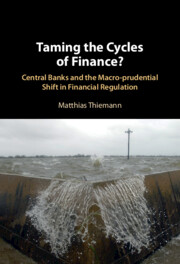Book contents
- Taming the Cycles of Finance?
- Taming the Cycles of Finance?
- Copyright page
- Contents
- Figures
- Tables
- Prologue
- Acknowledgments
- 1 Introduction
- 2 The Changing Regulation of Finance after the Crisis
- 3 The Evolution of Systemic Risk Thinking Pre-crisis
- 4 The Selective Rise of Macro-prudential Ideas in the Wake of the Crisis
- 5 Is Resilience Enough?
- 6 From the Global to the Local
- 7 Taming Liquidity and Leverage in the Shadow Banking Sector
- 8 Into the Upswing
- 9 The Crisis That Wasn’t
- 10 Conclusion
- Appendix: List of Interviews Conducted
- References
- Index
1 - Introduction
Published online by Cambridge University Press: 15 February 2024
- Taming the Cycles of Finance?
- Taming the Cycles of Finance?
- Copyright page
- Contents
- Figures
- Tables
- Prologue
- Acknowledgments
- 1 Introduction
- 2 The Changing Regulation of Finance after the Crisis
- 3 The Evolution of Systemic Risk Thinking Pre-crisis
- 4 The Selective Rise of Macro-prudential Ideas in the Wake of the Crisis
- 5 Is Resilience Enough?
- 6 From the Global to the Local
- 7 Taming Liquidity and Leverage in the Shadow Banking Sector
- 8 Into the Upswing
- 9 The Crisis That Wasn’t
- 10 Conclusion
- Appendix: List of Interviews Conducted
- References
- Index
Summary
Chapter 1 introduces the reader to macro-prudential policy and exposes the reader to the problem of persistently instable financial markets, which raise the question of if and how far the macro-prudential regulatory program post-crisis had any effect. In contrast to binary paradigm shift views, which see no to little change, I introduce a multidimensional view of regulatory change that can detect massive change in the economic ideas underlying financial regulation, while pointing to the administrative and political limitations that prevent these ideas from becoming fully performative. Pointing to these contradictions, the chapter introduces the analytical framework and the main contributions of the book, followed by an outline of the different chapters.
Keywords
- Type
- Chapter
- Information
- Taming the Cycles of Finance?Central Banks and the Macro-prudential Shift in Financial Regulation, pp. 1 - 22Publisher: Cambridge University PressPrint publication year: 2024

